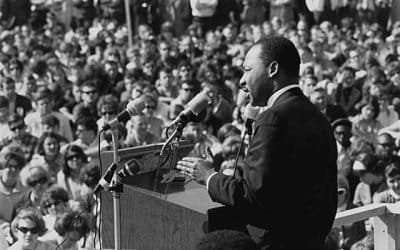The attack was well-choreographed. Moving in successive waves, they executed a perfect assault. Some moved to cut off their enemies’ supply lines, seizing control of crucial bridges and roadways, while others worked to surround and besiege key command and control buildings.
No, these were not U.S. commandos on a mission in Baghdad. They were anti-war protestors on Mission Street in San Francisco.
There, as elsewhere across the nation, well-planned demonstrations targeted not the military or the government, but the financial districts, the commuter roadways, the schools and universities. Their goal was not to advocate, but to disrupt.
Both protestors and their detractors have agreed on one thing: that these protests are examples of freedom of speech. “This is what democracy looks like” is the common refrain.
But these protests are not a benevolent manifestation of the freedom to express ideas. They are an attempt by a small gang of protesters to “express themselves” by forcibly imposing themselves on others.
Freedom of speech is the right to communicate ideas, information and values. It includes, in the words of the First Amendment, the right to “petition the government for a redress of grievances” and to assemble “peaceably” for that purpose. Freedom of speech protects debate and dispute. It does not protect coercion, nor does one person’s freedom of speech authorize him to force others to listen. No one has the right to violate rights.
Yet that is precisely what the anti-war demonstrators have done. Declaring their desire to halt “business as usual” in America, protesters have chained themselves across major thoroughfares to block rush-hour traffic in New York, Chicago, San Francisco and other cities. They have blockaded office buildings, smashed the windows of police cars and squirted red paint on Republican Party headquarters. In San Francisco alone the cost of the first day’s protests–counting only physical damage and police overtime, not lost wages and productivity for the besieged–was estimated at half a million dollars.
The goal of the protestors is to impose their anti-war tirades on a public that does not agree with them, and to do so by forcibly disrupting the lives of commuters, office workers, government officials and political opponents. They spread their message not through persuasion, but by blocking roadways, shutting down classes, besieging office buildings, smashing property. So much for their alleged goals of peace and brotherhood.
The issue is not merely that some protestors have resorted to outright violence and destruction. Just as wrong are such acts of “non-violent” coercion as imprisoning workers and commuters by obstructing public streets. There is a fundamental difference between rational persuasion and coercive interference, whatever form the interference may take.
The crime of these protestors is not that they are wrong about the war. In advocating their political views, they violate no one’s rights. But there is a crucial distinction between ideas and actions, between holding obnoxious views and forcibly imposing them on others.
Nor is “civil disobedience” inherently wrong. There are cases, such as the Montgomery bus boycott, in which protests are a justified and even heroic measure to defy and confront injustice. But truly peaceful civil disobedience consists of the refusal to support unjust practices or comply with unjust laws. It does not consist of a refusal to respect the rights of others.
In their insistence that vandalism and blockades are protected by the principle of free speech, the demonstrators turn this idea on its head. For them, freedom of speech becomes not a right to debate, but a right to violent disruption. For them, “democracy” becomes what it meant in its origins in Ancient Greece: the absolute right of the screaming masses to dispose of the individual’s life, liberty and property.
The fundamental basis for freedom of speech is a respect for the rational mind, which requires the freedom to weigh the evidence, to dispute and debate, without fear of coercive interference. By their reliance on chanted slogans, forcible blockades and the brute physical intimidation of mob gatherings, the so-called peace protestors show their contempt for the mind. It is confession of intellectual and moral bankruptcy, a confession that, for them, rational argumentation does not matter: all that matters is that their opponents are cowed into submission.
The banner of free speech is reserved for those who respect the rights of others and offer arguments addressed to our minds. It does not protect the mindless rabble who clog the streets of our cities proclaiming a fraudulent “right” to smash windows for the cause of peace.



